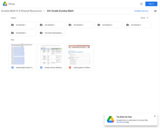
6th Grade Eureka Math Activities, Assessments
- Subject:
- Mathematics
- Material Type:
- Activity/Lab
- Assessment
- Author:
- Liberty Public Schools
- Date Added:
- 06/10/2021

6th Grade Eureka Math Activities, Assessments

Students' conceptual understanding of chemical reactions is foundational to much science learning. Understanding atomic level reactions is crucial for learning physical, life, earth, and space science. Even more importantly, they open up new windows of curiosity for students to see the world around them. By seventh grade, students are ready to take on the abstract nature of the interactions of atoms and molecules far too small to see.
To pique students’ curiosity and anchor the learning for the unit in the visible and concrete, students start with an experience of observing and analyzing a bath bomb as it fizzes and eventually disappears in the water. Their observations and questions about what is going on drive learning that digs into a series of related phenomena as students iterate and improve their models depicting what happens during chemical reactions. By the end of the unit, students have a firm grasp on how to model simple molecules, know what to look for to determine if chemical reactions have occurred, and apply their knowledge to chemical reactions to show how mass is conserved when atoms are rearranged.
Embedded in this unit are a variety of assessments, including self, peer, formative, and summative assessment tasks. This unit concludes with a transfer task in which students apply what they have figured out to two different related phenomena, elephant’s toothpaste and the crumbling of the marble that makes up the Taj Mahal.
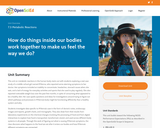
This unit on metabolic reactions in the human body starts out with students exploring a real case study of a middle-school girl named M’Kenna, who reported some alarming symptoms to her doctor. Her symptoms included an inability to concentrate, headaches, stomach issues when she eats, and a lack of energy for everyday activities and sports that she used to play regularly. She also reported noticeable weight loss over the past few months, in spite of consuming what appeared to be a healthy diet. Her case sparks questions and ideas for investigations around trying to figure out which pathways and processes in M’Kenna’s body might be functioning differently than a healthy system and why.
Students investigate data specific to M’Kenna’s case in the form of doctor’s notes, endoscopy images and reports, growth charts, and micrographs. They also draw from their results from laboratory experiments on the chemical changes involving the processing of food and from digital interactives to explore how food is transported, transformed, stored, and used across different body systems in all people. Through this work of figuring out what is causing M’Kenna’s symptoms, the class discovers what happens to the food we eat after it enters our bodies and how M’Kenna’s different symptoms are connected.

This unit on matter cycling and photosynthesis begins with students reflecting on what they ate for breakfast. Students are prompted to consider where their food comes from and consider which breakfast items might be from plants. Then students taste a common breakfast food, maple syrup, and see that according to the label, it is 100% from a tree.
Based on the preceding unit, students argue that they know what happens to the sugar in syrup when they consume it. It is absorbed into the circulatory system and transported to cells in their body to be used for fuel. Students explore what else is in food and discover that food from plants, like bananas, peanut butter, beans, avocado, and almonds, not only have sugars but proteins and fats as well. This discovery leads them to wonder how plants are getting these food molecules and where a plant’s food comes from.
Students figure out that they can trace all food back to plants, including processed and synthetic food. They obtain and communicate information to explain how matter gets from living things that have died back into the system through processes done by decomposers. Students finally explain that the pieces of their food are constantly recycled between living and nonliving parts of a system.
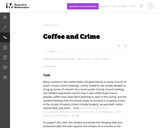
This task addresses many standards regarding the description and analysis of bivariate quantitative data, including regression and correlation. Students should recognize that the pattern shown is one of a strong, positive, linear association, and thus a correlation coefficient value near +1 is plausible. Students should also be able to interpret the slope of the least-squares line as an estimated increase in y per unit change in x (and thus for a 3 unit increase in x, students should expect an estimated increase in y that equals 3 times the model's slope value).
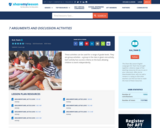
These activities can be used for a range of grade levels. They are group activities - a group in the class is given one activity. Each activity has success criteria on the back allowing children to work independently.
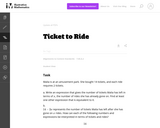
This is a task from the Illustrative Mathematics website that is one part of a complete illustration of the standard to which it is aligned. Each task has at least one solution and some commentary that addresses important asects of the task and its potential use. Here are the first few lines of the commentary for this task: Malia is at an amusement park. She bought 14 tickets, and each ride requires 2 tickets. Write an expression that gives the number of tickets Malia has ...
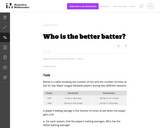
This is a task from the Illustrative Mathematics website that is one part of a complete illustration of the standard to which it is aligned. Each task has at least one solution and some commentary that addresses important asects of the task and its potential use. Here are the first few lines of the commentary for this task: Below is a table showing the number of hits and the number of times at bat for two Major League Baseball players during two different seasons: SeasonDe...
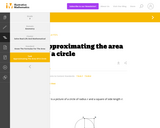
This is a task from the Illustrative Mathematics website that is one part of a complete illustration of the standard to which it is aligned. Each task has at least one solution and some commentary that addresses important aspects of the task and its potential use.
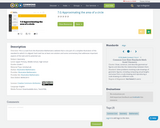
This is a task from the Illustrative Mathematics website that is one part of a complete illustration of the standard to which it is aligned. Each task has at least one solution and some commentary that addresses important aspects of the task and its potential use.
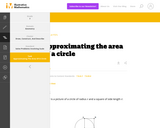
This is a task from the Illustrative Mathematics website that is one part of a complete illustration of the standard to which it is aligned. Each task has at least one solution and some commentary that addresses important aspects of the task and its potential use.
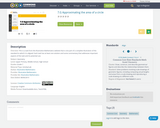
This is a task from the Illustrative Mathematics website that is one part of a complete illustration of the standard to which it is aligned. Each task has at least one solution and some commentary that addresses important aspects of the task and its potential use.
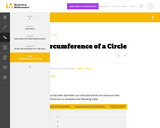
This is a task from the Illustrative Mathematics website that is one part of a complete illustration of the standard to which it is aligned. Each task has at least one solution and some commentary that addresses important aspects of the task and its potential use.
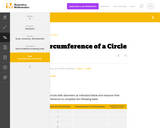
This is a task from the Illustrative Mathematics website that is one part of a complete illustration of the standard to which it is aligned. Each task has at least one solution and some commentary that addresses important aspects of the task and its potential use.
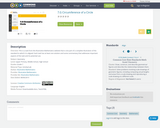
This is a task from the Illustrative Mathematics website that is one part of a complete illustration of the standard to which it is aligned. Each task has at least one solution and some commentary that addresses important aspects of the task and its potential use.
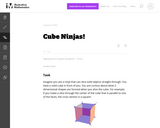
This is a task from the Illustrative Mathematics website that is one part of a complete illustration of the standard to which it is aligned. Each task has at least one solution and some commentary that addresses important asects of the task and its potential use. Here are the first few lines of the commentary for this task: Imagine you are a ninja that can slice solid objects straight through. You have a solid cube in front of you. You are curious about what 2-dimensional ...
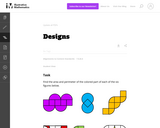
This is a task from the Illustrative Mathematics website that is one part of a complete illustration of the standard to which it is aligned. Each task has at least one solution and some commentary that addresses important asects of the task and its potential use. Here are the first few lines of the commentary for this task: Find the area and perimeter of the colored part of each of the six figures below. The purple, blue, orange, red, and green figures are composed of smal...
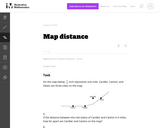
This is a task from the Illustrative Mathematics website that is one part of a complete illustration of the standard to which it is aligned. Each task has at least one solution and some commentary that addresses important asects of the task and its potential use. Here are the first few lines of the commentary for this task: On the map below, $\frac14$ inch represents one mile. Candler, Canton, and Oteen are three cities on the map. If the distance between the real towns of...

This is a task from the Illustrative Mathematics website that is one part of a complete illustration of the standard to which it is aligned. Each task has at least one solution and some commentary that addresses important aspects of the task and its potential use.
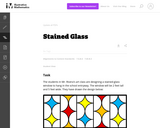
This is a task from the Illustrative Mathematics website that is one part of a complete illustration of the standard to which it is aligned. Each task has at least one solution and some commentary that addresses important asects of the task and its potential use. Here are the first few lines of the commentary for this task: The students in Mr. Rivera's art class are designing a stained-glass window to hang in the school entryway. The window will be 2 feet tall and 5 feet w...